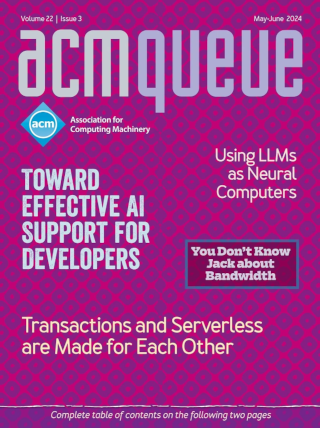
Why Logical Clocks are Easy:
Sometimes all you need is the right language.
Any computing system can be described as executing sequences of actions, with an action being any relevant change in the state of the system. For example, reading a file to memory, modifying the contents of the file in memory, or writing the new contents to the file are relevant actions for a text editor. In a distributed system, actions execute in multiple locations; in this context, actions are often called events. Examples of events in distributed systems include sending or receiving messages, or changing some state in a node. Not all events are related, but some events can cause and influence how other, later events occur. For example, a reply to a received mail message is influenced by that message, and maybe by prior messages received.
Statistics for Engineers:
Applying statistical techniques to operations data
Modern IT systems collect an increasing wealth of data from network gear, operating systems, applications, and other components. This data needs to be analyzed to derive vital information about the user experience and business performance. For instance, faults need to be detected, service quality needs to be measured and resource usage of the next days and month needs to be forecast.
Borg, Omega, and Kubernetes:
Lessons learned from three container-management systems over a decade
Though widespread interest in software containers is a relatively recent phenomenon, at Google we have been managing Linux containers at scale for more than ten years and built three different container-management systems in that time. Each system was heavily influenced by its predecessors, even though they were developed for different reasons. This article describes the lessons we’ve learned from developing and operating them.
Use-Case 2.0:
The Hub of Software Development
Use cases have been around for almost 30 years as a requirements approach and have been part of the inspiration for more-recent techniques such as user stories. Now the inspiration has flown in the other direction. Use-Case 2.0 is the new generation of use-case-driven development-light, agile, and lean-inspired by user stories and the agile methodologies Scrum and Kanban.
GNL is Not Linux:
What’s in a Name?
What, indeed, is in a name? As you’ve already seen, this quasi-technical topic continues to cause a bit of heat in the software community, particularly in the open-source world. You can find the narrative from the GNU side by clicking on the link provided in the postscript to this article, but KV finds that narrative lacking, and so, against my better judgment about pigs and dancing, I will weigh in with a few comments.
More Encryption Means Less Privacy:
Retaining electronic privacy requires more political engagement.
When Edward Snowden made it known to the world that pretty much all traffic on the Internet was collected and searched by the NSA, GCHQ (the UK Government Communications Headquarters) and various other countries’ secret services as well, the IT and networking communities were furious and felt betrayed.
Delegation as Art:
Be someone who makes everyone else better.
When I started my career as a junior engineer, I couldn’t wait to be senior. I would regularly review our promotion guidelines and assess my progress and contributions against them. Of course, at the time I didn’t really understand what being senior meant. Being a senior engineer means having strong technical skills, the ability to communicate well and navigate ambiguous situations, and most important of all, the ability to grow and lead other people. Leadership isn’t just for managers anymore.





